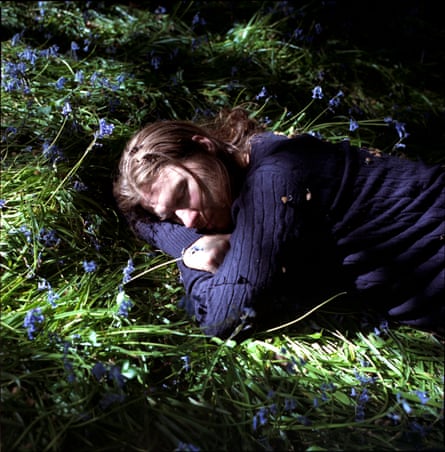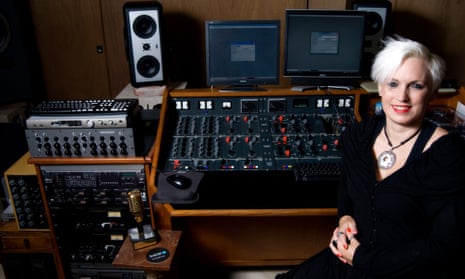Walk into Mandy Parnell’s studio and you might think you were on LA’s Sunset Strip, not Walthamstow, east London. There are animal skulls and guitars on the walls, a vinyl press, an enormous 70s wicker pod. Crisp music booms out of the five enormous speakers that encircle her computer desk.
Parnell is one of the country’s leading mastering engineers, and this is where the likes of the Chemical Brothers, Max Richter and Brian Eno come to hear their finished tracks. Parnell has polished a huge number of albums here including, last year, Jamie xx’s In Colour and Aphex Twin’s Syro.She is also one of the few women in the male-dominated production world. At tonight’s Music Producers Guild awards – which she describes as the “technical Grammys” – she is one of only two female nominees out of 36 (the other, Manon Grandjean, is up for breakthrough engineer). The MPG says that an estimated 6% of their membership is female, based on a sample survey they sent out last year.
Parnell reckons that women have to work twice as hard. “You put lots of men in a studio and it’s that ‘Who’s going to be top dog?’ pack mentality. You’ve got to be able to deal with that,” she says. “I’ve found that I needed to understand technology a lot more than some of my peers. I’d get a producer really challenging me on a technical level, yet they’d want to talk about the football [with the male engineers].”

Born in Essex, Parnell grew up playing with records rather than dolls. “My parents had a greasy cafe in Wickford and the jukebox guy would give me the old seven-inches. Then life went a bit haywire and I ended up running away and was on the streets.” But she happened to have a friend who was a housekeeper at Richard Branson’s Oxford studio The Manor and the first time she went inside, she knew she wanted to work behind the mixing desk. “It was like that,” she says, clicking her fingers.
Parnell went straight back to London and got on to a music production course. “It took me three years to get a paid job after finishing, though it’s even harder now.” She was “taken on as ‘the woman’ during the Maggie Thatcher era of encouraging women into ‘men’s’ roles”. But she also says that, to her, tokenism is irrelevant. “If you’re passionate about something it doesn’t matter. If you want it you’ve got to fight for it.”
It is for her forward-thinking work on Björk’s last two albums – 2011’s Biophilia and 2015’s break-up album Vulnicura – that Parnell is perhaps best known. Working on Vulnicura was particularly intense, she says. “I was going through a breakup with my husband, the father of my son, and able to relate to Björk.” (Her former husband, the late New Orleans jazz pianist Phil Parnell, died from liver cancer eight months after Vulnicura’s release.)
The album was not without its technical challenges either – amplified when Björk began to combine her music with virtual reality. The Icelandic singer’s Björk Digital exhibition last year comprised a number of VR music videos that the audience could step inside, such as Stonemilker’s sweeping 360 and 3D vistas of Björk on a beach. Parnell was drafted in to make sure the audio worked inside the headsets.
“There’s virtual reality, which works on a gaming engine and then you have 360, which is a film that’s all around you,” explains Parnell. “To do the mix for 360 is complicated, the technology isn’t quite there, because it’s not surround sound – you’re going to move your head inside this experience – so the sound has to relate to your movement. When it comes to an audio mix, especially Björk’s, there are untold layers of sounds, drums, vocals, keyboards and strings. To try and get that to feel natural wherever you move is very difficult. And it needs to feel natural otherwise you’ll get motion sickness.”
All of which sounds impossibly convoluted but by all accounts Björk relishes such puzzles. In a 2015 Pitchfork interview the Icelandic singer made headlines for calling out the sexist assumption that she has less input than her (often male) co-producers. Parnell scoffs at the idea. “She’s ridiculously involved. She pushes you out the way!” she laughs. She demonstrates Björk’s knack for hogging the keyboard over her desk. “Slowly she leans across to get the mouse and within half an hour she’s here and you’re there!”

Many more female artists self-produce now, from Leila Arab to Mica Levi and Shura, whose debut album Parnell mastered last year. But, given that 6% figure, clearly there is still work to be done to get more women working in studios. “I mentor female engineers from all over the world. I say: ‘Look! Been there, done it, worn the T-shirt – if you get any sexist problems, come talk to me.’ We need to get young women over the fear [and say] ‘You can do this!’”
The biggest challenge to Parnell’s work these days is the glut of ways we now consume music. “Often producers joke that it doesn’t really matter, it’s just going to end up as an MP3 on a phone with a kid listening to it down the street.” What’s more, music is changing according to new platforms. “We have Spotify, YouTube, iTunes, Tidal – they’re all doing very different things to the audio in terms of compression,” she says, which in turn affects the depth and scale of what you’re listening to. “There’s a lot of distortion out there.”
In many ways, all this means the role of the sound engineer is more important than ever. After the mixing engineer has worked their magic, mastering people like Parnell must ensure that the final mix is balanced and refined so that it sounds pristine, whether pumping out of an audiophile stereo or a hissy mobile phone. Even so, she says, “if the emotional intention of the music gets across, it shouldn’t matter what we listen to it on”. Take Bob Marley’s Jammin: “It doesn’t matter how you play it, where you play it, on what system: it just works.”
- The Music Producers Guild Awards are on 16 February. Mandy runs Black Saloon Studios.

Comments (…)
Sign in or create your Guardian account to join the discussion